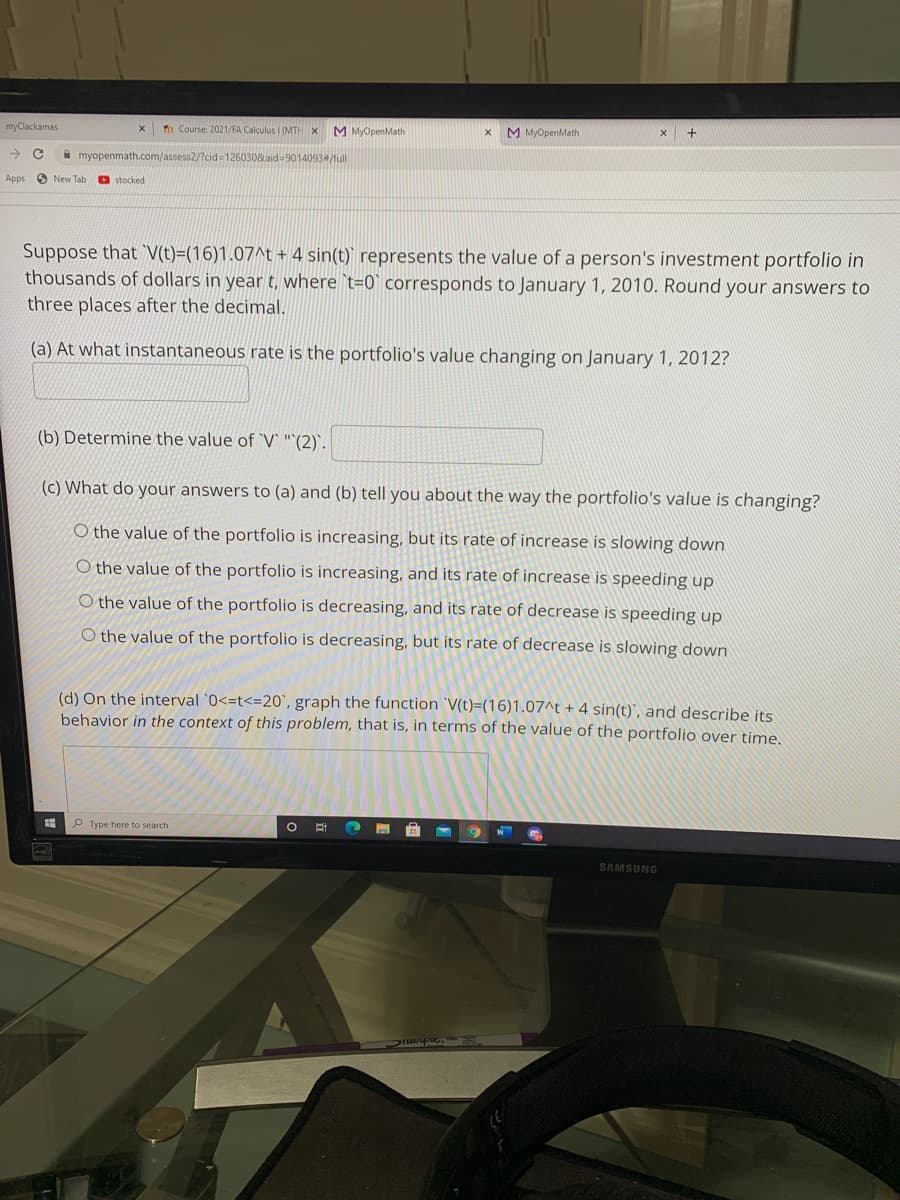Suppose that V(t)=(16)1.07^t + 4 sin(t)` represents the value of a person's investment portfolio in thousands of dollars in year t, where 't=0` corresponds to January 1, 2010. Round your answers to three places after the decimal. (a) At what instantaneous rate is the portfolio's value changing on January 1, 2012? (b) Determine the value of 'V' "(2)'. (c) What do your answers to (a) and (b) tell you about the way the portfolio's value is changing? O the value of the portfolio is increasing, but its rate of increase is slowing down O the value of the portfolio is increasing, and its rate of increase is speeding up O the value of the portfolio is decreasing, and its rate of decrease is speeding up O the value of the portfolio is decreasing, but its rate of decrease is slowing down (d) On the interval '0<=t<=20°, graph the function `V(t)=(16)1.07^t + 4 sin(t)', and describe its behavior in the context of this problem, that is, in terms of the value of the portfolio over time.
Suppose that V(t)=(16)1.07^t + 4 sin(t)` represents the value of a person's investment portfolio in thousands of dollars in year t, where 't=0` corresponds to January 1, 2010. Round your answers to three places after the decimal. (a) At what instantaneous rate is the portfolio's value changing on January 1, 2012? (b) Determine the value of 'V' "(2)'. (c) What do your answers to (a) and (b) tell you about the way the portfolio's value is changing? O the value of the portfolio is increasing, but its rate of increase is slowing down O the value of the portfolio is increasing, and its rate of increase is speeding up O the value of the portfolio is decreasing, and its rate of decrease is speeding up O the value of the portfolio is decreasing, but its rate of decrease is slowing down (d) On the interval '0<=t<=20°, graph the function `V(t)=(16)1.07^t + 4 sin(t)', and describe its behavior in the context of this problem, that is, in terms of the value of the portfolio over time.
Calculus: Early Transcendentals
8th Edition
ISBN:9781285741550
Author:James Stewart
Publisher:James Stewart
Chapter1: Functions And Models
Section: Chapter Questions
Problem 1RCC: (a) What is a function? What are its domain and range? (b) What is the graph of a function? (c) How...
Related questions
Question

Transcribed Image Text:myClackamas
n Course: 2021/FA Calculus I (MTH x
M MyOpenMath
M MyOpenMath
A myopenmath.com/assess2/?cid=1260308aid=9014093/full
Apps
O New Tab
O stocked
Suppose that V(t)=(16)1.07^t + 4 sin(t)' represents the value of a person's investment portfolio in
thousands of dollars in year t, where `t=0` corresponds to January 1, 2010. Round your answers to
three places after the decimal.
(a) At what instantaneous rate is the portfolio's value changing on January 1, 2012?
(b) Determine the value of `V` "`(2)`.
(c) What do your answers to (a) and (b) tell you about the way the portfolio's value is changing?
O the value of the portfolio is increasing, but its rate of increase is slowing down
O the value of the portfolio is increasing, and its rate of increase is speeding up
O the value of the portfolio is decreasing, and its rate of decrease is speeding up
O the value of the portfolio is decreasing, but its rate of decrease is slowing down
(d) On the interval `0<=t<=20`, graph the function `V(t)=(16)1.07^t + 4 sin(t)`, and describe its
behavior in the context of this problem, that is, in terms of the value of the portfolio over time.
P Type here to search
SAMSUNG
Expert Solution
This question has been solved!
Explore an expertly crafted, step-by-step solution for a thorough understanding of key concepts.
This is a popular solution!
Trending now
This is a popular solution!
Step by step
Solved in 2 steps with 2 images

Recommended textbooks for you

Calculus: Early Transcendentals
Calculus
ISBN:
9781285741550
Author:
James Stewart
Publisher:
Cengage Learning

Thomas' Calculus (14th Edition)
Calculus
ISBN:
9780134438986
Author:
Joel R. Hass, Christopher E. Heil, Maurice D. Weir
Publisher:
PEARSON

Calculus: Early Transcendentals (3rd Edition)
Calculus
ISBN:
9780134763644
Author:
William L. Briggs, Lyle Cochran, Bernard Gillett, Eric Schulz
Publisher:
PEARSON

Calculus: Early Transcendentals
Calculus
ISBN:
9781285741550
Author:
James Stewart
Publisher:
Cengage Learning

Thomas' Calculus (14th Edition)
Calculus
ISBN:
9780134438986
Author:
Joel R. Hass, Christopher E. Heil, Maurice D. Weir
Publisher:
PEARSON

Calculus: Early Transcendentals (3rd Edition)
Calculus
ISBN:
9780134763644
Author:
William L. Briggs, Lyle Cochran, Bernard Gillett, Eric Schulz
Publisher:
PEARSON

Calculus: Early Transcendentals
Calculus
ISBN:
9781319050740
Author:
Jon Rogawski, Colin Adams, Robert Franzosa
Publisher:
W. H. Freeman


Calculus: Early Transcendental Functions
Calculus
ISBN:
9781337552516
Author:
Ron Larson, Bruce H. Edwards
Publisher:
Cengage Learning